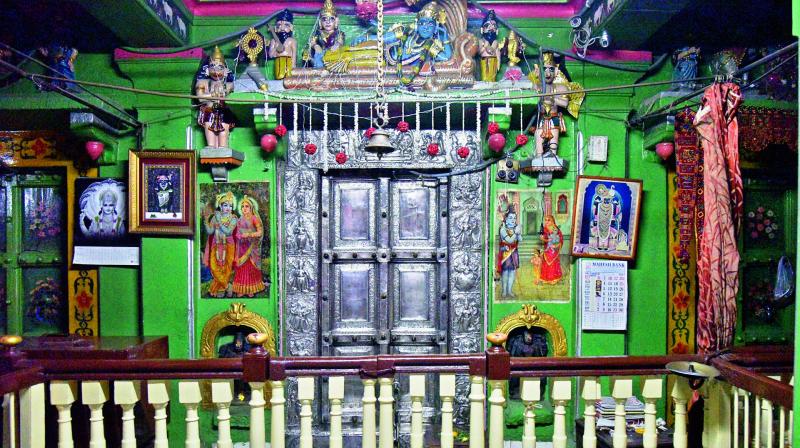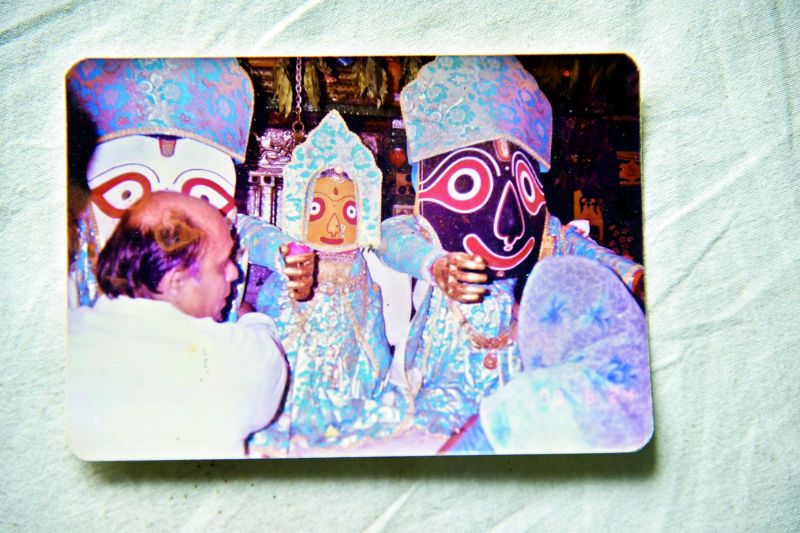Puri-like temple in Hyderabad's General Bazaar
Numerous rituals are followed and all the pujas are done in madi.

Hyderabad: The name General Bazaar says it all. You can find everything you needed with bargains renting the air as two-wheeler riders vie with ladies on a shopping spree, while the uninitiated sift through. You find clothes, shoes, and eatables like sandwiches, ice-creams and fresh greens, all temptingly priced. Amidst the trade-related din, there is a quiet place — Sri Puri Jaganath Swamy temple.
Walk down the main lane and then take a left at the first break on the road, whose narrowness increases as you proceed; and then there are immense gates with hand-written warnings that you will be fined Rs 500 for parking vehicles in front of the imposing gates. Don’t let that keep you from entering the inner spaces of this temple. Recently done up, the entrance is tall and clean with a fresh coat of paint and monkeys hang around on the ledge of the wall near the ceiling. Small doors lead to smaller storerooms and behind one of them are the steps leading to the first floor of the temple, where you can see through the glass ceiling.
 The idols of Balabhadra, Subhadra and Jaganath Swamy housed in the sanctum sanctorum. The idols were initially kept under a huge peepal tree in the temple premises. (Photo: DC)
The idols of Balabhadra, Subhadra and Jaganath Swamy housed in the sanctum sanctorum. The idols were initially kept under a huge peepal tree in the temple premises. (Photo: DC)
Just before entering the temple, on the right is a huge peepul tree (or bodhi tree) and under it the idols of Balabhadra, Subhadra and Jaganath Swamy were placed before a sanctum was built for them. According to Harikishen Malani, whose forefather helped construct the current building, where the Bairagi Babas were doing the puja earlier. His great great, grandfather Ramgopal Malani used to visit this temple for darshan those days. He would dine with the seers there. Babaji Lakshman Das told him to build a permanent structure if he ever made money. Thus, the current structure was built by Ramgopal who died in 1923.
“They were not rich. He used to live in Alwal and would walk to the Mint everyday to collect change or the Osmania Sikkas and give them in the market to earn some money for himself,” says Harikishen.
Ramgopal had a fixed time even as the British Resident would pass by in his buggy. One day, the Resident got curious about Ramgopal and stopped the buggy and asked him the details. After that meeting, they would travel together and one day the Resident asked him if he would like to take up a job. Soon, Ramgopal started supplying lubricants to the railways. He then began making his own oil in a ghani (a traditional method of oil processing) and made some money. Slowly, he started doing railway construction works on the Wadi, Manmad and Dornakal lines. This was with the Nizam Guaranteed State Railways.
Ramgopal was a philanthropist. He gave as nazarana to Mehboob Ali Khan the old Fateh Maidan Club, which was razed to the ground and is known as LB Stadium now. Among the other magnificent structures were the Clock Tower of St John's Church and DBR Mills. The Ramgopalpet police station, which still stands tall amidst all the traffic chaos, is also one of the structures which Ramgopal built. In fact, he has contributed a lot towards the construction outside Hyderabad also.
In 1930, the temple was registered in the name of Jagannath Swamy with the customs and rituals are as per the Puri temple in Odisha. “The Vallabhacharya Pusthi Marg combined with the Puri rituals are performed in the temple every day. The focus with this sampradaya is not on the puja but on seva,” says Harikishen. In 1960, the endowment department took over the Sri Jaganath Swamy Ramgopal Trust. “Till the 80s, the trust ran in a loss and all the expenses were borne by us,” said Harikishen. Then the rents were increased and slowly the trust prospered and now is being managed by the clan, which includes the families of Harikishen and his brother, Ramesh Malani.
Though situated in a noisy space, the temple is like an oasis. A small driveway leads you to a few steps and then you enter the age-old portals, full of nakashi embossments on the wall and pillars. There are cusped arches with decorative medallions atop them. There is a glass enclosure on top for light. It is a combination of architectural styles with the Rajasthani influence. A small section containing an idol of Lord Hanuman, standing opposite the main deities, is the place for devotees. An upward glance gifts you with the sight of colourful rasa leela, running as a motif around the place. In fact, huge paintings adorn the walls and here too the dresses and jewellery suggest the Rajasthani influence.
A lot of rituals are followed and all the pujas are done in madi. “In fact, if we go to the temple, we too have to have a bath and wear new clothes,” said Harikishen.
Priesthood in this temple is not hereditary. There are four priests and one of them is dedicated to singing keerthans.
Pradeep Kumar Gautam, originally from Sawai Madhapur in Rajasthan, with his education from Brindavan Gurukul in Mathura, has been here for 11 years and firmly believes that this temple grants your wishes. “I am an example,” he says. “We had a girl child after a long time and my sister wanted to adopt her. But I told her that I will hand over my second child to her. She wanted only a girl child. After much prayers we had fraternal twins and I handed over my second daughter to my sister. I wanted a son and I got that wish also granted,” he says happily.
“Why, the person who helped build this temple grew to be a seth from being a munim,” he adds, referring to Ramgopal.
Everything is made at this temple, including the ‘bhog’ which is given to the Lord at various times. In fact, flower malas from outside also are not allowed in. If a devotee gets the flowers, the mala is made at the temple. The clothes for the gods are also stitched in-house. In fact, this god is coddled. In the winter, he gets an angeethi and in the summer a khus khus curtain to keep things cool and fragrant. Each year, maintenance of the temple is done.

